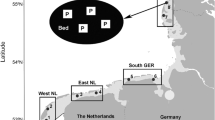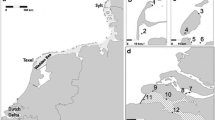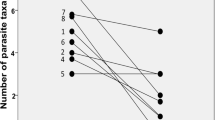Abstract
The alteration of habitat structure by introduced ecosystem engineers imposes direct impacts on native biota but can also exert trait-mediated indirect effects. In this study, we show that the habitat structure provided by invasive Pacific oysters (Crassostrea gigas) can also indirectly affect parasitism in native blue mussels (Mytilus edulis). We conducted a 3-month field experiment, in which uninfected mussels were positioned at the bottom and top of two intertidal oyster reefs in the Wadden Sea. On one reef, we detected a significantly higher prevalence of parasitic copepods (Mytilicola spp.) in mussels positioned on top of oysters than in mussels at the bottom, but no difference in infection intensity. For trematodes (Renicola roscovita), a different pattern was observed, with higher prevalence (one reef) and significantly higher infection intensities (both reefs) in mussels positioned at the bottom of the oyster reef. We suggest that the contrasting pattern results from differences in parasite life cycles. Mytilicola spp. larvae spend 2–3 weeks in the water column before infecting their hosts and, therefore, mussels positioned at the top are exposed to higher numbers of planktonic larvae than mussels at the bottom. In contrast, infective trematode larvae spend less than 12 h in the water column and primarily infect mussels during low tide, which may explain higher prevalence and intensity of R. roscovita in mussels near the bottom of the oyster reef. Our results demonstrate that indirect effects leading to alterations of parasite-host interactions may be a more common but hitherto rarely considered impact of biological invasions.





Similar content being viewed by others
Data accessibility
Data is archived at https://data.4tu.nl/repository/, https://doi.org/10.4121/12826154.
References
Abrams PA (1995) Implications of dynamically variable traits for identifying, classifying and measuring direct and indirect effects in ecological communities. Am Nat 146:112–134
Bartoli P, Boudouresque C-F (1997) Transmission failure of parasites (Dignea) in sites colonized by the recent introduced invasive alga Caulerpa taxifolia. Mar Ecol Prog Ser 154:253–260
Bates D, Maechler M, Bolker B, Walker S (2015) Fitting linear mixed-effects models using lme4. J Stat Softw 67:1–48
Buschbaum C, Cornelius A, Goedknegt MA (2016) Deeply hidden inside introduced biogenic structures-Pacific oyster reefs reduce detrimental barnacle overgrowth on native blue mussels. J Sea Res 117:20–26
Byers JE (2010) Variable direct and indirect effects of a habitat-modifying invasive species on mortality of native fauna. Ecology 91:1797–1798
Crooks JA (2002) Characterizing ecosystem-level consequence of biological invasions: the role of ecosystem engineers. Oikos 97:153–166
Curtis LA (1987) Vertical distribution of an estuarine snail altered by a parasite. Science 235:1509–1511
Decaestecker E, de Meester L, Ebert D (2002) In deep trouble: habitat selection constrained by multiple enemies in zooplankton. PNAS 99:5481–54885
Drinkwaard AC (1999) Introductions and developments of oysters in the North Sea area: a review. Helgoländer Meeresun 52:301–308
Elsner NO, Jacobsen S, Thieltges DW, Reise K (2011) Alien parasitic copepods in mussels and oysters of the Wadden Sea. Helgoland Mar Res 65:299–307
Elton CS (1958) The ecology of invasions by animals and plants. Methuen, London
Eschweiler N, Christensen HT (2011) Trade-off between increased survival and reduced growth for blue mussels living on Pacific oyster reefs. J Exp Mar Biol Ecol 403:90–95
Feis ME, Goedknegt MA, Thieltges DW, Buschbaum C, Wegner KM (2016) Biological invasions and host–parasite coevolution: different coevolutionary trajectories along separate parasite invasion fronts. Zoology 119:366–374
Feis ME, John U, Lokmer A, Luttikhuizen PC, Wegner KM (2018) Dual transcriptomics reveals co-evolutionary mechanisms of intestinal parasite infections in blue mussels Mytilus edulis. Mol Ecol 27:1505–1519
Fournier DA, Skaug HJ, Ancheta J, Ianelli J, Magnusson A, Maunder M, Nielsen A, Siebert J (2012) AD Model Builder: using automatic differentiation for statistical inference of highly parameterised complex nonlinear models. Optim Method Softw 27:233–249
Gee JM, Davey JT (1986a) Stages in the life history of Mytilicola intestinalis STEUER, a copepod parasite of Mytilus edulis (L.), and the effect of temperature on their rates of development. ICES J Mar Sci 42:254–264
Gee JM, Davey JT (1986b) Experimental studies on the infestations of Mytilus edulis (L.) by Mytilicola intestinalis Steuer (Copepoda, Cyclopoida). J Cons Int Explor Mer 42:265–271
Goedknegt MA, Welsh J, Drent JE, Tieltges DW (2015) Climate change and parasite transmission: how temperature affects parasite infectivity via predation on infective stages. Ecosphere 6:96. https://doi.org/10.1890/ES15-00016.1
Goedknegt MA, Feis ME, Wegner KM, Luttikhuizen PC, Buschbaum C, Camphuysen K, van der Thieltges DW (2016) Parasites and marine invasions: ecological and evolutionary perspectives. J Sea Res 113:11–27
Goedknegt MA, Schuster A-K, Buschbaum C, Gergs R, Jung AS, Luttikhuizen PC, van der Meer J, Troost K, Wegner KM, Thieltges DW (2017) Spillover but no spillback of two invasive parasitic copepods from invasive Pacific oyster (Crassostrea gigas) to native bivalve hosts. Biol Invasions 19:365–379
Goedknegt MA, Thieltges DW, van der Meer J, Wegner KM, Luttikhuizen PC (2018) Cryptic invasion of a parasitic copepod: compromised identification when morphologically similar invaders co-occur in invaded ecosystems. PLoS ONE 13(3):e0193354. https://doi.org/10.1371/journal.pone.0193354
Goedknegt MA, Nauta R, Markovic M, Buschbaum C, Folmer EO, Luttikhuizen PC, van der Meer J, Waser AM, Wegner KM, Thieltges DW (2019) How invasive oysters can affect parasite infection patterns in native mussels on a large spatial scale. Oecologia 190:99–111
Goedknegt MA, Buschbaum C, van der Meer J, Wegner KM, Thieltges DW (2020) Introduced marine ecosystem engineer indirectly affects parasitism in native mussel host. Royal Netherlands Institute for Sea Research (NIOZ). Dataset. https://doi.org/10.4121/12826154
Grabowski JH (2004) Habitat complexity disrupts predator-prey interactions but not the trophic cascade on oyster reefs. Ecology 85:995–1004
Grainger JN (1951) Notes on the biology of the copepod Mytilicola intestinalis Steuer. Parasitology 41:135–142
Gribben PE, Byers JE, Clements M, McKenzie LA, Steinberg PD, Wright JT (2009) Behavioural interactions between ecosystem engineers control community species richness. Ecol Lett 12:1127–1136
Griffen BD, Riley ME, Cannizzo ZJ, Feller IC (2017) Indirect effects of ecosystem engineering combine with consumer behaviour to determine the spatial distribution of herbivory. J Anim Ecol 86:1425–1433
Guy-Haim T, Lyons DA, Kotta J et al (2018) Diverse effects of invasive ecosystem engineers on marine biodiversity and ecosystem functions: a global review and meta-analysis. Glob Change Biol 24:906–924
Hockley AR (1951) On the biology of Mytilicola intestinalis (Steuer). J Mar Biol Assoc UK 30:223–232
Hughes AR, Grabowski JH (2006) Habitat context influences predator interference interactions and the strength of resource partitioning. Oecologia 149:256–264
Johnson PTJ, Thieltges DW (2010) Diversity, decoys and the dilution effect: how ecological communities affect disease risk. J Exp Biol 213:961–970
Jones CG, Lawton JH, Schacchak M (1994) Organisms as ecosystem engineers. Oikos 69:373–386
Jones CG, Lawton JH, Schacchak M (1997) Positive and negative effects of organisms as physical ecosystem engineers. Ecology 78:1946–1957
Koprivnikar J, Poulin R (2009) Effects of temperature, salinity, and water level on the emergence of marine cercariae. Parasitol Res 105:957–965
Li H, Zhang XM, Zheng RS, Li X, Elmer WH, Wolfe LM (2014) Indirect effects of non-native Spartina alterniflora and its fungal pathogen (Fusarium palustre) on native saltmarsh plants in China. J Ecol 102:112–1119
Mack RN, Simberloff D, Londsdale WM, Evans H, Clout M, Bazzaz FA (2000) Biotic invasions: causes, epidemiology, global consequences, and control. Ecol Appl 10:689–710
Meyer PF, Mann H (1950) Beiträge zur Epidemiologie und Physiologie des parasitischen Copepoden Mytilicola intestinalis. Arch Fischereiwiss 2:120–134
Moehler J, Wegner KM, Reise K, Jacobsen S (2011) Invasion genetics of Pacific oyster Crassostrea gigas shaped by aquaculture stocking practices. J Sea Res 66:256–262
Mori T (1935) Mytilicola orientalis, a new species of parasitic Copepoda. Zool Soc Jpn 47:687–693
Mourant A, Lecomte N, Moreau G (2017) Indirect effects of an ecosystem engineer: how the Canadian beaver can drive the reproduction of saproxylic beetles. J Zool 304:90–97
Mouritsen KN (2002a) The Hydrobia ulvae–Maritrema subdolum association: influence of temperature, salinity, light, water pressure and secondary host exudates on cercarial emergence and longevity. J Helminthol 76:341–347
Mouritsen KN (2002b) The Hydrobia ulvae–Maritrema subdolum association: cercarial emergence controlled by host activity. J Helminthol 76:349–353
Mouritsen KN, Jensen KT (1997) Parasite transmission between soft-bottom invertebrates: temperature mediated infection rates and mortality in Corophium volutator. Mar Ecol Prog Ser 151:123–134
Nicolaev KE, Prokofiev VV, Levakin IA, Galaktionov KV (2017) How the position of mussels at the intertidal lagoon affects their infection with the larvae of parasitic flatworms (Trematoda: Digenea): a combined laboratory and field experimental study. J Sea Res 128:32–40
Pearson DE (2010) Trait- and density-mediated indirect interactions initiated by an exotic invasive plant autogenic ecosystem engineer. Am Nat 176:394–403
Petersen JK, Bougrier S, Smaal AC, Garen P, Robert S, Larsen JEN, Brummelhuis E (2004) Intercalibration of mussel Mytilus edulis clearance rate measurements. Mar Ecol Prog Ser 267:187–194
Pogoda B, Jungblut S, Buck BH, Hagen W (2012) Infestation of oysters and mussels by mytilicolid copepods: differences between natural coastal habitats and two offshore cultivation sites in the German Bight. J Appl Ichthyol 28:756–765
R Development Core Team (2015) R: a language and environment for statistical computing. R Foundation for Statistical Computing, Vienna, Austria. https://www.R-project.org/
Reise K (1998) Pacific oysters invade mussel beds in the European Wadden Sea. Mar Biodivers 28:167–175
Reise K, Buschbaum C, Büttger H, Wegner KM (2017a) Invading oysters and native mussels: from hostile takeover to compatible bedfellows. Ecosphere 8(9):e01949. https://doi.org/10.1002/ecs2.1949
Reise K, Buschbaum C, Büttger RJ, Wegner KM (2017b) Invasion trajectory of Pacific oysters in the Wadden Sea. Mar Biol 164:68
Ruesink JL, Lenihan HS, Trimble AC, Heiman KW, Micheli F, Byers JE, Kay MC (2005) Introduction of non-native oysters: ecosystem effects and restoration implications. Ann Rev Ecol Evol S 36:643–689
Sanders D, Jones CG, Thébault E, van der Heide T, van Belzen J, Barot S (2014) Integrating ecosystem engineering and food webs. Oikos 123:513–524
Stephenson JF, van Oosterhout C, Mohammed RS, Cable J (2015) Parasites of Trinidadian guppies: evidence for sex- and age-specific trait-mediated indirect effects of predators. Ecology 96:489–498
Stier T, Drent J, Thietges DW (2015) Trematode infections reduce clearance rates and condition in blue mussels Mytilus edulis. Mar Ecol Prog Ser 529:137–144
Thieltges DW (2006) Effect of infection by the metacercarial trematode Renicola roscovita on growth in intertidal blue mussel Mytilus edulis. Mar Ecol Prog Ser 319:129–134
Thieltges DW (2007) Habitat and transmission—effect of tidal level and upstream host density on metacercarial load in an intertidal bivalve. Parasitology 134:599–605
Thieltges DW, Reise K (2007) Spatial heterogeneity in parasite infections at different scales in an intertidal bivalve. Oecologia 150:569–581
Thieltges DW, Rick J (2006) Effect of temperature on emergence, survival and infectivity of cercariae of the marine trematode Renicola roscovita (Digenea: Renicolidae). Dis Aquat Organ 73:63–68
Thieltges DW, Reise K, Prinz K, Jensen KT (2009) Invaders interfere with native parasite-host interactions. Biol Invasions 11:1421–1429
Troost K (2010) Causes and effects of a highly successful marine invasion: case-study of the introduced Pacific oyster Crassostrea gigas in continental NW European estuaries. J Sea Res 64:145–165
Vitousek P, D’Antonio C, Loope LL, Westbrooks R (1996) Biological invasions as global environmental change. Am Sci 84:468–478
Waser AM, Splinter W, van der Meer J (2015) Indirect effects of invasive species affecting the population structure of an ecosystem engineer. Ecosphere 6:109. https://doi.org/10.1890/ES14-00437.1
Welsh JE, van der Meer J, Brussaard CPD, Thieltges DW (2014) Inventory of organisms interfering with transmission of a marine trematode. J Mar Biol Assoc UK 94:697–702
Werding B (1969) Morphologie, Entwicklung und Ökologie digener Trematoden-Larven der Strandschnecke Littorina littorea. Mar Biol 3:306–333
Wetzel WC, Screen RM, Li I et al (2016) Ecosystem engineering by a gall-forming wasp indirectly suppresses diversity and density of herbivores on oak trees. Ecology 97:427–438
White J-S, O’Donnell S (2010) Indirect effects of a key ecosystem engineer alter survival and growth of foundation coral species. Ecology 91:3538–3548
Acknowledgements
We are grateful to Jarco Havermans, Sarah Bedolfe and Annabelle Dairain who supported us during the set-up and the monitoring of the experiment. We are also thankful to two anonymous reviewers who gave constructive comments on an earlier version of the manuscript. This study was financially supported by the Netherlands Organization for Scientific Research (NWO) and the German Bundesministerium für Bildung und Forschung (BMBF) (NWO-ZKO Project 839.11.002).
Author information
Authors and Affiliations
Corresponding author
Additional information
Publisher's Note
Springer Nature remains neutral with regard to jurisdictional claims in published maps and institutional affiliations.
Electronic supplementary material
Below is the link to the electronic supplementary material.
Rights and permissions
About this article
Cite this article
Goedknegt, M.A., Buschbaum, C., van der Meer, J. et al. Introduced marine ecosystem engineer indirectly affects parasitism in native mussel hosts. Biol Invasions 22, 3223–3237 (2020). https://doi.org/10.1007/s10530-020-02318-1
Received:
Accepted:
Published:
Issue Date:
DOI: https://doi.org/10.1007/s10530-020-02318-1




